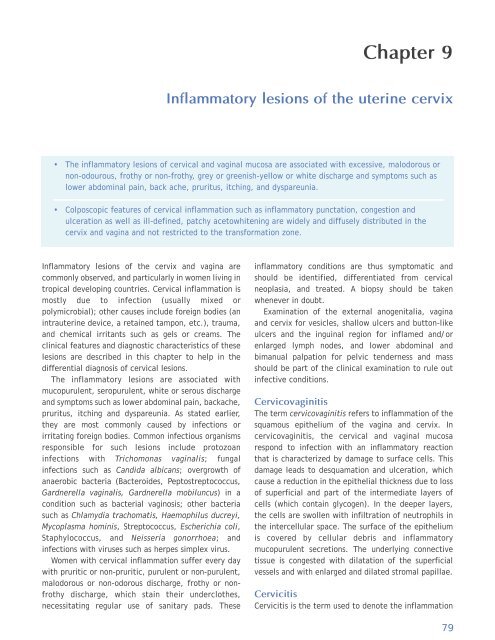Colposcopy and Treatment of Cervical Intraepithelial Neoplasia - RHO
Colposcopy and Treatment of Cervical Intraepithelial Neoplasia - RHO
Colposcopy and Treatment of Cervical Intraepithelial Neoplasia - RHO
Create successful ePaper yourself
Turn your PDF publications into a flip-book with our unique Google optimized e-Paper software.
Chapter 9<br />
Inflammatory lesions <strong>of</strong> the uterine cervix<br />
• The inflammatory lesions <strong>of</strong> cervical <strong>and</strong> vaginal mucosa are associated with excessive, malodorous or<br />
non-odourous, frothy or non-frothy, grey or greenish-yellow or white discharge <strong>and</strong> symptoms such as<br />
lower abdominal pain, back ache, pruritus, itching, <strong>and</strong> dyspareunia.<br />
• Colposcopic features <strong>of</strong> cervical inflammation such as inflammatory punctation, congestion <strong>and</strong><br />
ulceration as well as ill-defined, patchy acetowhitening are widely <strong>and</strong> diffusely distributed in the<br />
cervix <strong>and</strong> vagina <strong>and</strong> not restricted to the transformation zone.<br />
Inflammatory lesions <strong>of</strong> the cervix <strong>and</strong> vagina are<br />
commonly observed, <strong>and</strong> particularly in women living in<br />
tropical developing countries. <strong>Cervical</strong> inflammation is<br />
mostly due to infection (usually mixed or<br />
polymicrobial); other causes include foreign bodies (an<br />
intrauterine device, a retained tampon, etc.), trauma,<br />
<strong>and</strong> chemical irritants such as gels or creams. The<br />
clinical features <strong>and</strong> diagnostic characteristics <strong>of</strong> these<br />
lesions are described in this chapter to help in the<br />
differential diagnosis <strong>of</strong> cervical lesions.<br />
The inflammatory lesions are associated with<br />
mucopurulent, seropurulent, white or serous discharge<br />
<strong>and</strong> symptoms such as lower abdominal pain, backache,<br />
pruritus, itching <strong>and</strong> dyspareunia. As stated earlier,<br />
they are most commonly caused by infections or<br />
irritating foreign bodies. Common infectious organisms<br />
responsible for such lesions include protozoan<br />
infections with Trichomonas vaginalis; fungal<br />
infections such as C<strong>and</strong>ida albicans; overgrowth <strong>of</strong><br />
anaerobic bacteria (Bacteroides, Peptostreptococcus,<br />
Gardnerella vaginalis, Gardnerella mobiluncus) in a<br />
condition such as bacterial vaginosis; other bacteria<br />
such as Chlamydia trachomatis, Haemophilus ducreyi,<br />
Mycoplasma hominis, Streptococcus, Escherichia coli,<br />
Staphylococcus, <strong>and</strong> Neisseria gonorrhoea; <strong>and</strong><br />
infections with viruses such as herpes simplex virus.<br />
Women with cervical inflammation suffer every day<br />
with pruritic or non-pruritic, purulent or non-purulent,<br />
malodorous or non-odorous discharge, frothy or nonfrothy<br />
discharge, which stain their underclothes,<br />
necessitating regular use <strong>of</strong> sanitary pads. These<br />
inflammatory conditions are thus symptomatic <strong>and</strong><br />
should be identified, differentiated from cervical<br />
neoplasia, <strong>and</strong> treated. A biopsy should be taken<br />
whenever in doubt.<br />
Examination <strong>of</strong> the external anogenitalia, vagina<br />
<strong>and</strong> cervix for vesicles, shallow ulcers <strong>and</strong> button-like<br />
ulcers <strong>and</strong> the inguinal region for inflamed <strong>and</strong>/or<br />
enlarged lymph nodes, <strong>and</strong> lower abdominal <strong>and</strong><br />
bimanual palpation for pelvic tenderness <strong>and</strong> mass<br />
should be part <strong>of</strong> the clinical examination to rule out<br />
infective conditions.<br />
Cervicovaginitis<br />
The term cervicovaginitis refers to inflammation <strong>of</strong> the<br />
squamous epithelium <strong>of</strong> the vagina <strong>and</strong> cervix. In<br />
cervicovaginitis, the cervical <strong>and</strong> vaginal mucosa<br />
respond to infection with an inflammatory reaction<br />
that is characterized by damage to surface cells. This<br />
damage leads to desquamation <strong>and</strong> ulceration, which<br />
cause a reduction in the epithelial thickness due to loss<br />
<strong>of</strong> superficial <strong>and</strong> part <strong>of</strong> the intermediate layers <strong>of</strong><br />
cells (which contain glycogen). In the deeper layers,<br />
the cells are swollen with infiltration <strong>of</strong> neutrophils in<br />
the intercellular space. The surface <strong>of</strong> the epithelium<br />
is covered by cellular debris <strong>and</strong> inflammatory<br />
mucopurulent secretions. The underlying connective<br />
tissue is congested with dilatation <strong>of</strong> the superficial<br />
vessels <strong>and</strong> with enlarged <strong>and</strong> dilated stromal papillae.<br />
Cervicitis<br />
Cervicitis is the term used to denote the inflammation<br />
79
















